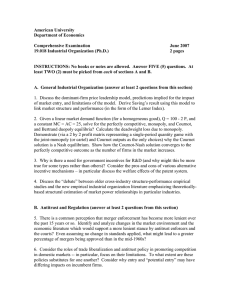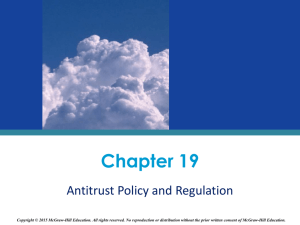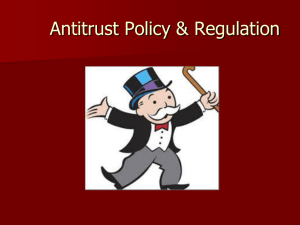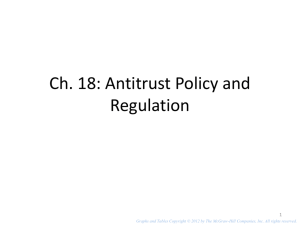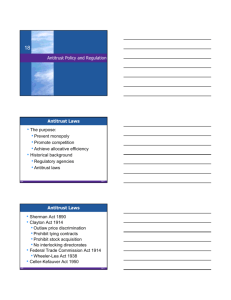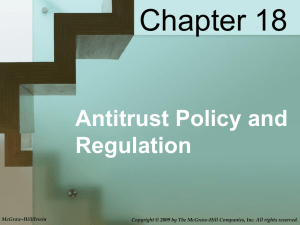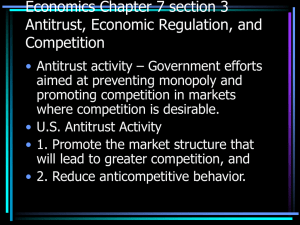Antitrust Policy Government regulation aimed at preventing
advertisement
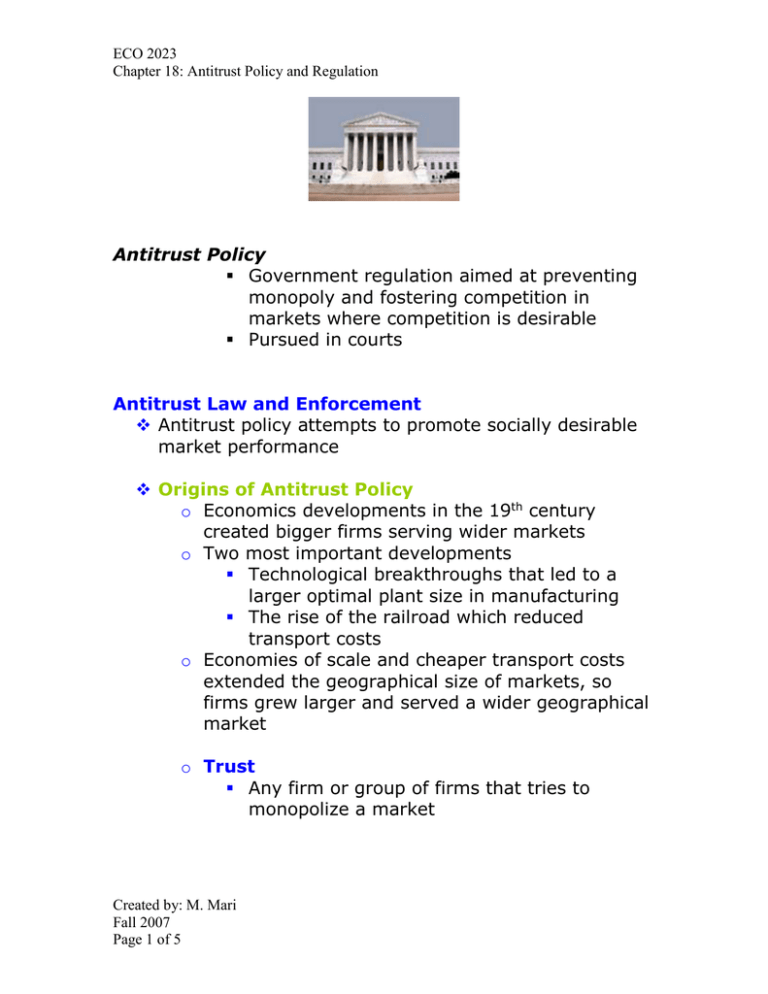
ECO 2023 Chapter 18: Antitrust Policy and Regulation Antitrust Policy Government regulation aimed at preventing monopoly and fostering competition in markets where competition is desirable Pursued in courts Antitrust Law and Enforcement Antitrust policy attempts to promote socially desirable market performance Origins of Antitrust Policy o Economics developments in the 19th century created bigger firms serving wider markets o Two most important developments Technological breakthroughs that led to a larger optimal plant size in manufacturing The rise of the railroad which reduced transport costs o Economies of scale and cheaper transport costs extended the geographical size of markets, so firms grew larger and served a wider geographical market o Trust Any firm or group of firms that tries to monopolize a market Created by: M. Mari Fall 2007 Page 1 of 5 ECO 2023 Chapter 18: Antitrust Policy and Regulation Antitrust Laws Sherman Antitrust Act of 1890 o First national legislation in the world against monopoly o Two provisions Section 1: Every contract, combination in the form of a trust or otherwise, or conspiracy, in restraint of trade or commerce among the several States, or with foreign nations is declared to be illegal. Section 2: Every person who shall monopolize or attempt to monopolize, or combine or conspire with any person or persons to monopolize any part of the trade or commerce among the several states, or with foreign nations, shall be deemed guilty or a felony. o Outlawed Restraints of trade Collusive price fixing Dividing up markets Prohibited trusts Monopolization o Treble damages available o Sound foundation for positive government action against business monopolies. o Vague and ineffective Clayton Act of 1914 o Contained the desired elaboration of the Sherman Act. o Four sections Section 2 outlaws price discrimination when such discrimination is not justified on the Created by: M. Mari Fall 2007 Page 2 of 5 ECO 2023 Chapter 18: Antitrust Policy and Regulation basis of cost differences and when it reduces competition. Section 3 prohibited tying contracts, in which a producer requires that a buyer purchase another of it products as a condition for obtaining a desired product. Section 7 prohibits the acquisition of stocks of competing corporations when the outcome would be less competition. Section 8 prohibits the formation of interlocking directorates – situations where a director of one firm is also a board member of a competing firm Federal Trade Commission Act of 1914 o Established a federal body to help enforce antitrust laws o Run by commissioners assisted by economists and lawyers o Gave FTC the power to investigate unfair competitive practices on its own initiative or at the request of injured firms. o Issue cease and desist orders where unfair methods of competition in commerce occur Wheeler-Lea Act of 1938 o Gave FTC the additional responsibility of policing deceptive acts or practices in commerce False or misleading advertising Misrepresentation of products o Established FTC as an independent antitrust agency o Made unfair and deceptive sales practices illegal. Created by: M. Mari Fall 2007 Page 3 of 5 ECO 2023 Chapter 18: Antitrust Policy and Regulation Celler-Kefauver Anti Merger Act o Amended the Clayton Act, Section 7, which prohibits a firm from merging with a competing firm o Which prevents one firm from buying the physical assets of another firm if the effect is to reduce competition o Prevents horizontal merger A merger which one firm combines with another that produces the same product o Prevents vertical merger A merger in which one firm combines with another from which it had purchased inputs or to which it had sold output o Allows conglomerate merger A merger of firms in different industries Issues of Interpretation Differences in judicial interpretations have led to vastly different applications of antitrust laws. Questions o Should the focus of antitrust policy be on monopoly behavior or on monopoly structure? o How broadly should markets be defined in antitrust cases? Monopoly Behavior vs. Structure o Standard Oil Case (1911) Found them guilty of monopolizing the petroleum industry through a series of abusive and anticompetitive actions Broke up the company o US Steel (1920) Courts established a rule of reason, saying that not every monopoly is illegal Size alone is not an offense Steel did not resort to illegal acts against competitors in obtaining monopoly power Created by: M. Mari Fall 2007 Page 4 of 5 ECO 2023 Chapter 18: Antitrust Policy and Regulation o ALCOA (1945) Possession of monopoly power is wrong o Does it act like a monopoly or does it look like a monopoly o Microsoft Charged with practicing like a monopolist Mergers Horizontal mergers o A merger which one firm combines with another that produces the same product o Exxon merges with Mobil Vertical merger o A merger in which one firm combines with another from which it had purchased inputs or to which it had sold output o Pizza Hut, Taco Bell, and KFC Conglomerate merger o A merger of firms in different industries o Walt Disney owns ABC, sports teams, cruise line Created by: M. Mari Fall 2007 Page 5 of 5

